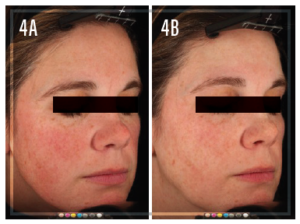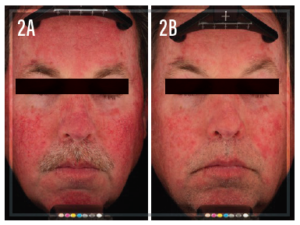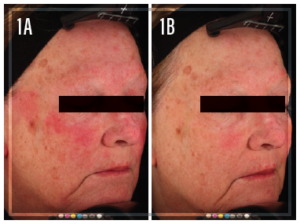VBeam Prima for Vascular Laser treatments
The Whitsunday Cosmedics Skin Clinic has recently acquired the latest technology for treating vascular and pigmented skin conditions – the Vbeam Prima.
Our new VBeam Prima is particularly recommended for broken capillaries, rejuvenating skin with sun damage or photo ageing, rosacea, red scars and port wine stains.
The Vbeam Prima is a highly efficient pulsed dye laser with dual wavelengths, dual cooling systems, giving a better and faster treatment experience overall. It has a number of indications for both face and body, including benign vascular and pigmented lesions, facial telangiectasia, and rosacea, and is a treatment with high patient tolerability and a low incidence of side effects.
Rosacea is a common skin condition that is historically difficult to treat and can lead to redness, flushing and broken blood vessels, often in the central face. However, the VBeam Prima, with its 595 and 1064nm wavelengths, offers a complete treatment even for persistent rosacea with larger vessels affected.
VBeam Prima Technology
Pulsed Dye Lasers deliver an intense but gentle burst of light into selectively targeted areas of the skin. The light is absorbed by specific blood vessels or melanin pigmented areas in the dermis. With its efficient cooling system and re-engineered hand piece, the VBeam Prima is the next generation pulse dyed laser.
Pictured above: Figures 1A, 2A & 4A – baseline before photos. Figues 1B, 2B & 4B were taken at the 2 month follow up post 4 treatments.
What to expect
It is recommended to avoid sun exposure before and throughout treatment to maximize results. A sunblock of SPF 30 or higher should be worn daily during this time.
At treatment time, your skin is firstly cleansed to remove any makeup, moisturising lotion and natural oils. The laser’s built-in cooling mechanisms will make the treatment more comfortable so there is no need for local anaesthetic. The epidermis of the skin is protected by the VBeam’s exclusive dynamic cooling method, DCD, which sprays a cooling mist onto the targeted area of skin before each laser pulse, maximising comfort and protecting the skin during treatment. As the laser pulses energy into the skin, you may feel a temporary warm or stinging sensation, which is very tolerable.
There may be some redness or mild swelling in the treated area immediately following treatment, and this usually goes away in a few hours. Occasionally some minor bruising may occur, but this is transient and usually disappears in three to five days.
Beneficial results are usually noted straight away, and often patients comment they feel a firming or tightening of the treated area. How long the results last will depend on many factors, including the condition being treated and the patient’s lifestyle. For example, if you have sunspots removed, and you continue to spend time in the sun without adequate skin protection, it is likely that the sunspots will return.
Indications
The VBeam Prima offers a platform capable of treating a wide range of indications, including:
- acne scarring
- benign vascular lesions
- benign pigmented lesions
- benign cutaneous lesions
- inflammatory acne vulgaris
- facial telangiectasia
- deep blue veins
- venous lakes
- wrinkles
- rosacea
- photo ageing
Please see below links to articles and further information regarding the treatment of these conditions-
VB57_2018_Pulsed dye laser treatment of rosacea using a novel 15 mm diameter treatment beam
PB98372EN Summary of Peer-Reviewed Articles Vbeam Family
VBCB01 Poikiloderma of Civatte – Eubanks[4]
If you’d like to benefit from treatment with the Vbeam Prima, call us on 4948 3962 to book for a consultation.
Any surgical or invasive procedure carries risks. Before proceeding, you should seek a second opinion from an appropriately qualified health practitioner.





